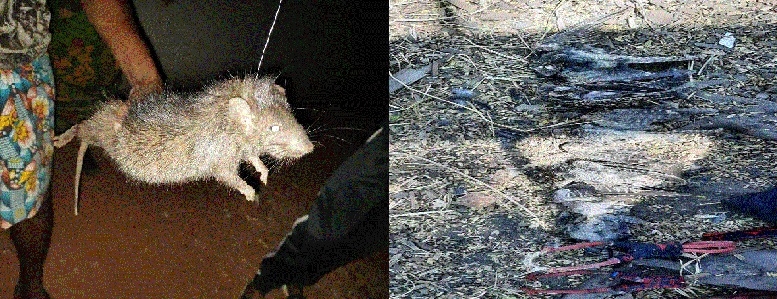Bushmeat hunting may cause another outbreak
| Date :22-Apr-2020 |

Giant bandicoot rat hunted at Darbha valley. (R) Birds killed by hunters who were caught up in crossfire.
By Roshan Chachane
RAIPUR
As the lockdown entered the second phase, most forested villages have blocked entry to outsiders and started hunting animals either to observe the banned tradition of Parad or Pandum just to satiate their gluttonous craving for highly pathogenic bushmeat. If the hunting of wild animals isn’t curbed, there is a very realistic chance of the emergence of a deadly zoonotic virus in Chhattisgarh. On April 9, sources informed about hunting of a giant wild rodent (Bandicoot Rat) in Darbha Valley of Bastar.
How fatal the consumption of bushmeat could get was witnessed very recently at Patelpara of Nakulnar in Dantewada on April 15, when one man died and four fell sick after eating the meat of an owl and one monitor lizard. Recently, two hunters had entered the forests to hunt birds and got caught in the crossfire between Naxals and Security Forces in Bijapur. One of the hunters died while another sustained grievous injuries. The men hunted some Koel birds the carcasses of which were recovered from the encounter site. Tribal areas of Chhattisgarh have a tradition of Parad or Pandum, wherein the whole village partakes in the hunting of wild animals. They hunt and eat wild animals like civet cats, pangolin, bats, wild boar or whatever animals they get their hands on.
The tribes hunt and consume wild animals like bats, civet cats, wild boar, flying squirrel or any other wild animal they can get their hands on. Such mindless hunting of wild animals don’t just pose a threat to the wild fauna, but it could one day result in the transmission of one of the many extremely dangerous zoonotic viruses into humans. There are numerous researches to prove that the aforementioned animals or any other wild animal is a reservoir of pathogens like novel coronavirus, a Zoonotic pathogen, which got transmitted from bats to humans via intermediate species of pangolin or snakes. The latest report published by Indian Council for Medical Research (ICMR) has sounded the alarm bell for Chhattisgarh as it found coronaviruses in the Pteropus and Rousettus species of bats from the different states of India. It’s crucial to note that both of these bats species are also found in Chhattisgarh and they are often hunted and eaten by tribal people.
Bats are known as reservoirs for over a dozen highly infectious viruses such as ebola virus, marburg virus or nipah virus to name a few. In 2018, Kozhikode in Kerala recorded the nipah virus outbreak, the virus was traced to fruit bats. Total of 18 confirmed cases and 16 deaths were registered. The case fatality rate was an astounding 88.8 per cent. The virus was also found to be human-to-human transmittable. The coronavirus which the mankind is suffering now is actually a result of genetic mutation in the virus found in bats over course of time.
Due to continuous hunting and feeding of bats, the virus needs new bodies to survive and therefore they adapt themselves. As far as monitor lizard is concerned, from its saliva to the guts, the creature is a factory of deadly bacteria and even venom (according to a research paper by a team of scientists at the University of Melbourne in 2005). Monitor lizard produces venom capable of producing hypotension (abnormally low blood pressure) and coagulopathy (bleeding disorder). Chhattisgarh tribes also eat wild boar, which is a vector of Classical Swine Fever Virus or Hog Cholera.
The disease is still enzootic, but it doesn’t take too long for an enzootic virus to transform into zoonotic as seen in the case of novel coronavirus. Tribes in Bastar also hunt flying squirrel for meat. Since flying squirrel is a species of rodent and rodents carry the extremely deleterious ‘Hantavirus’, which can cause diseases haemorrhagic fever with renal syndrome (HFRS) and Hantavirus cardiopulmonary syndrome (HCPS). According to the Centre for Disease Control and Prevention (CDC), HCPS has a fatality rate of 38%, much higher than Novel Corona Severe Acute Respiratory Syndrome nCOV-SARS-2019. The Pangolin was found to be the immediate host of novel coronavirus-2019 whereas civet cats are the carrier of parvovirus transmitted to them by bats. There is a plethora of research data suggesting wild animals are the vectors of extremely contagious and deadly pathogens.
The only way to prevent these pathogens from getting mutated and transmit to the human body is to keep humans as far away from the wildlife as possible by force, education or any mean. Principal Chief Conservator of Forest (PCCF) Wildlife Atul Shukla stated, the tribal practice of Parad or Pandum, under which the people go in the forest to hunt and eat wild animals, is proscribed. Yet, they sneakily continue these practices in the name of tradition. If the Department goes too tough on them, they have to face the political backlash. Awareness and education is crucial in stopping such regressive practices, PCCF acknowledged.
